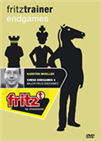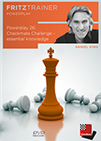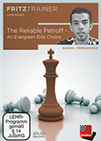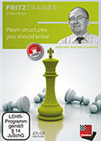A match away from a dream
"So what colour do you prefer for the first game of your match [at the World Cup]," asked Eteri Kublashvili to Ding Liren. After some thought Ding replied, "Normally it is better to play black first like in soccer games. For example, in an event like European Championships the team that plays away first has some advantage."
Grischuk, who was standing next to Ding, chimed in, "But you know Vitiugov starts with white, wins with white every time and wins the match!" [laughter]. And it's true! Vitiugov played some of the best chess of his life at the World Cup 2019 and in rounds three and four he eliminated Sergey Karjakin and Wesley So without going into the tiebreaks. In both matches Vitiugov scored 1½-½, showing tremendous chess with the white pieces. Let's have a look at both the games and learn from the Russian GM.

Vitiugov was sublime at the World Cup 2019 with the white pieces | Photo: FIDE
In this well known Anti-Berlin position Vitiugov took on c6 with his bishop.
 The Ruy Lopez is one of the oldest openings which continues to enjoy high popularity from club level to the absolute world top. In this video series, American super GM Fabiano Caruana, talking to IM Oliver Reeh, presents a complete repertoire for White.
The Ruy Lopez is one of the oldest openings which continues to enjoy high popularity from club level to the absolute world top. In this video series, American super GM Fabiano Caruana, talking to IM Oliver Reeh, presents a complete repertoire for White.
The move 11.h4 is a very interesting one. White gains space on the kingside. He may castle long, but right now he doesn't want to commit his king. At the same time pushing the pawn h5-h6 is bound to create some soft points in the position where Black can be attacked.
Now this is a new direction. White plays his pawn to a4, in a way saying to Black — look I am not going to castle short or long. I am going to keep my king in the centre where it will be safe. While you have a problem on hand now: your a5 pawn is slightly weak.
When Vitiugov took the knight on d4, Black has three ways to recapture. How would you take on d4?
Definitely Karjakin's 16...♛xd4 was incorrect. Better was to play exd4 attack the knight and push it back to f1. Yes, the bishop on b6 is slightly passive, but so is the knight on f1. And this would have been the right way to continue the game.
See how the h6 pawn comes in handy?
Vitiugov has managed to place his strong opponent in great danger. Black's e5 pawn is weak and thanks to the h6 pawn and opposite coloured bishop situation, the king on g8 is also feeling the heat.
Will you exchange the queens or not?
30.b3! was a fine move by Vitiugov. Next he goes ♕a1, ♖1e2, ♕a1-e1, the bishop goes to c3 and e5 will become very difficult to defend!
The rooks have come off the board but White is still better because his queen and bishop create quite some problems
 The third part of the endgame series tackles queen endings, rook against minor pieces, queen against rook and queen against two rooks. Queen endings are not nearly as mysterious as they appear at first sight. Knowing a few rules of thumb and principles will make things very much easier for you.
The third part of the endgame series tackles queen endings, rook against minor pieces, queen against rook and queen against two rooks. Queen endings are not nearly as mysterious as they appear at first sight. Knowing a few rules of thumb and principles will make things very much easier for you.
Over 7 hours video training.
After some repetition Karjakin blundered in this position. He played 52...♛d5. Can you finish off the game?
 Checkmate. That's the aim of the game. There are numerous ways to checkmate the enemy king, but there are common patterns that recur over and over again, and having these at our mental fingertips is essential for when we want to finish the game.
Checkmate. That's the aim of the game. There are numerous ways to checkmate the enemy king, but there are common patterns that recur over and over again, and having these at our mental fingertips is essential for when we want to finish the game.
53.♗c5+ and it is a mate in few moves. You can work out the details!

That was some high class chess by Vitiugov | Photo: FIDE

After beating Sergey Karjakin in round 3, it was now time for Wesley So | Photo: FIDE
 The Petroff (or Russian) Defence which is characterised by the moves 1.e4 e5 2.Nf3 Nf6 has been popular at the highest levels for many years and enjoys the reputation of being an extremely solid defence.
The Petroff (or Russian) Defence which is characterised by the moves 1.e4 e5 2.Nf3 Nf6 has been popular at the highest levels for many years and enjoys the reputation of being an extremely solid defence.
Wesley So has always played the Petroff when he wants a solid game with black pieces. Vitiugov went for 3.d4.
After eight moves we reach this position. What is your assessment? Who do you think is better?
In such positions the way one would understand what's going on is through Silman's "method of imbalance". But before we go there I would like to ask you whether the pawns on c2 and c3 look weak to you?
 Every pawn structure has its typical plans and to know these plans helps you to find your way in these positions. On this DVD Mikhalchishin presents and explains the most common central structures: The Hedgehog, the Maroczy, Hanging pawns and the Isolani.
Every pawn structure has its typical plans and to know these plans helps you to find your way in these positions. On this DVD Mikhalchishin presents and explains the most common central structures: The Hedgehog, the Maroczy, Hanging pawns and the Isolani.
When you look at this 4 vs 3 rook endgame, the question that needs to be asked is — Which pawn structure do you think is better? It is natural to think that with the pawns on h7-g6-f7, Black's position is pretty good. However, having the pawns on f7 and f6 has its own benefits. If you look closely, one of the main ways in which White plays for a win in the left diagram is to try and extract a passed e-pawn, while this is very difficult in the first position, it is absolutely impossible in the second diagram because of the doubled f-pawns! If one black pawn exchanges itself with the e-pawn, there is another one still left and White doesn't get a passed pawn. Now let's come back to the Vitiugov vs So position:
Although this is a theoretical position, I would like to take a look at it in some detail. The main reason being the interesting imbalances in this position. Let's jot down the imbalances:
- The first thing that strikes you is the pawn structure. Black clearly seems to have a better structure as he doesn't have any doubled pawns like White has on the c-file.
- Thanks to the e5 pawn, White has some space advantage.
- White has a majority on the kingside while Black has a majority on the queenside.
- White has the semi open b-file which could prove useful.
After listing the imbalances you begin to understand a few things. The pawn structure is really not the main thing in the position. It would have been if Black had knights on the board. Imagine adding a knight on d7 and a white knight on f3. Suddenly things are not so clear, because the knight gets a very nice square on c5. As there are only bishops on the board, White doesn't have to worry about his pawn weaknesses for now. Also the pawns on c2-c3 prevent Black pawns from advancing easily on the queenside.
Imagine you had a pawn on b2 instead of c3. One can easily imagine the move c5 being more powerful as then Black wants to run down White with c4, d4 and so on. With the doubled pawns, it is not so easy for Black to push on. For White on the other hand, the pawn majority on the kingside is easier to expand with f4-f5. Black can stop White pawns after f4, by playing ...f5. However, that gives White a passed pawn on e5, as we see in the game. All in all I feel that the position is slightly better for White.
When White went 10.f4, Wesley decided that he cannot let these pawns keep rolling and hence met it with 10...f5. While this stopped the f-pawn in its tracks, it allows White a passed pawn on e5.
White plays his pawn to 12.a4. This doesn't have a particular purpose, but it just gains space on the queenside.
Black has just played his queen to c7. How should White continue?
Vitiugov came up with a very nice plan. Playing against opponent's weaknesses is his strength. He figured that the pawn on d5 is weak and should be pressurized systematically.
Well done if you found the move 17.♕f2, with the idea of rerouteing the bishop to f3 via e2.
When you put micro problems to your opponent, they are bound to go wrong! Here the pawn moves to b6, defending c5, but it gives White an additional option to create further play with the a5 breakthrough!
Now there are two weaknesses for Black to take care of — b5 and d5 — while c3 which theoretically should be a bad pawn is actually the best pawn in White's position. It restrains everything in Black's position.
White's pressure is slowly building up. How should you continue?
Vitiugov realized the importance of shifting the pieces once again. The bishop has done its role on f3, it is now time to get it to e2 to attack b5. White began with...
26.♖b2! I really like this move. White will next play ♕f1 and then ♗e2. The queen can next make her way to b1 and it is not going to be easy to hold the b5 pawn.
Look at how beautifully Vitiugov has arranged his pieces. This is pure art! All his pieces are attacking something, while all of Black's pieces are just defending!
Vitiugov managed to play accurately right until the very end and won the game!
Chess is often quite cruel!
The way Vitiugov was playin — as can be seen from the above two games — he should have made it to the finals and booked a spot for himself at the Candidates. However, look at how things turned around just within a couple of days. Vitiugov had to play a marathon encounter against Yu Yangyi in the fifth round that went all the way to Armageddon.

Armageddon spelled the end for Vitiugov | Photo: FIDE
The match went right up to the final game in the Armageddon! In the last game of the match Vitiugov with black needed a draw to qualify. He had four minutes as compared to Yu Yangyi who had five, but was in a must-win situation.
Yu Yangyi blundered big time right out of the opening with 9.♗e4. Can you see how this is a huge mistake?
Vitiugov took the pawn on g2 and next the one on f4 and was well on his way to victory!
Can you believe that, from the above position, a player like Vitiugov, who was in such great form at the World Cup, couldn't win?

The end of the road for the Russian GM
After the tiebreak, a dejected Vitiugov sat in his chair after the loss for 2-3 minutes reflecting on what he had done.
Later he tweeted:
This tournament is like life - eventually, it has a sad end. Lucky guys leave it quickly, stubborn ones, who fight on their limits - sometimes painfully. But what happened here also matters and I am proud of the level of chess I've showed in the tournament (not today:-).
Vitiugov is a fine chess player. He has won the Gibraltar Masters in the past, recently competed at the Grenke Classic, won the Prague Masters in 2019 and has been in the top finishers at the Russian Super League for many years. He is right up there with the best, but has not received enough invitations to play at the absolute elite tournaments. For a player like him, finishing in top two of the World Cup would mean the biggest breakthrough of his chess career — an entry into the Candidates! And how close he was! Oh well, that's how chess is! Unpredictable.
Links





























